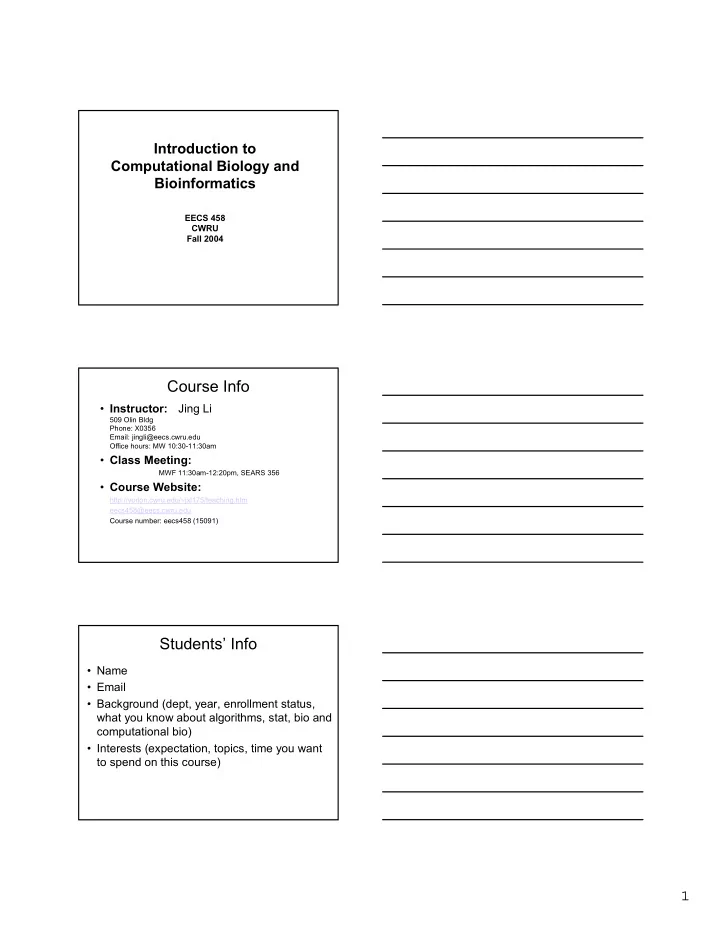

Introduction to Computational Biology and Bioinformatics EECS 458 CWRU Fall 2004 Course Info • Instructor: Jing Li 509 Olin Bldg Phone: X0356 Email: jingli@eecs.cwru.edu Office hours: MW 10:30-11:30am • Class Meeting: MWF 11:30am-12:20pm, SEARS 356 • Course Website: http://vorlon.cwru.edu/~jxl175/teaching.htm eecs458@eecs.cwru.edu Course number: eecs458 (15091) Students’ Info • Name • Email • Background (dept, year, enrollment status, what you know about algorithms, stat, bio and computational bio) • Interests (expectation, topics, time you want to spend on this course) 1
Areas in computational biology • Sequencing: to determine the sequence of DNA and Proteins • Sequence analysis: – Sequence comparison – Gene recognition – Pattern discovery • Statistical genetics/polymorphisms: – Gene mapping – Linkage and association study Areas in computational biology • Comparative genomics: phylogenetics, evolution • Functional genomics: gene expression array • System biology – Pathways – Regulatory networks – Protein interaction networks Areas in computational biology • Proteomics: – Sequencing, folding/structure, functions • Drug discovery in the post-genomic era – Biomarkers – High throughput screen – Docking 2
Course Overview • Intro to molecular bio – Cell, DNA, RNA, Proteins – Central dogma – Human genome – DNA sequencing • Intro to probability, hidden Markov models, and applications Course Overview • Genomics (sequence analysis) – Sequence alignments (dynamic programming, hmm) – Gene prediction (hmm) – Motif/Pattern identification (suffix tree, statistical methods) • Genomic variations – Gene mapping – Haplotype inference – Population genetics Course Overview • Evolution – Phylogeny reconstruction • Functional genomics – Microarray data analysis (mining and learning) • Proteomics – Sequencing – Structure/function prediction • System bio – Pathways – Protein interaction networks 3
Main Purposes • Basic concepts/techniques in molecular bio/genetics • Current topics in comp bio • Mathematical methods: – DP, Graph, String algorithms – Learning algorithms (HMM, Clustering/ Classification) – Statistical methods • Research experience Course Format / Grade • HW: 4 assignments, 40% – Mainly design/analysis of algorithms • Project/presentation: 60% – Team of 2-3 – Topics will be provided or selected by your own. – Examples: proposal of new methods, improvement on previous results, applying methods on new formulations. – Presentation in class. – Term paper. What you will not learn here: • How to use existing software/databases • How to collect data experimentally • Molecular biology • Genetics/ Epidemiology • Statistics 4
Relevant Courses o EECS 433: Database Systems o EECS 435: Data Mining o EECS 454: Analysis of Algorithms o EPBI 452: Statistical Methods in Human Genetics o EPBI 457: Genetic Linkage Analysis o EPBI 471: Statistical Aspects of Data Mining o EPBI 491: Epidemiology: Application of Theory and Methods o EPBI 492: Epidemiology: Statistical Methods and Modeling o GENE 508: Bioinformatics and Computational Genomics o GENE 509: Complex Genetic Traits o STAT 445/446: Theoretical Statistics I/II o BIOC 618: Biology and Mathematics of Microarray Studies Reference books 0262161974 0521585198 Reference books 0412993910 0521629713 5
Reference books 026202506 0805346333 Reference books http://www.ncbi.nlm.nih.gov/books/ 0131439812 Acknowledgements • Professor Tao Jiang • Professor Stefano Lonardi 6
Recommend
More recommend